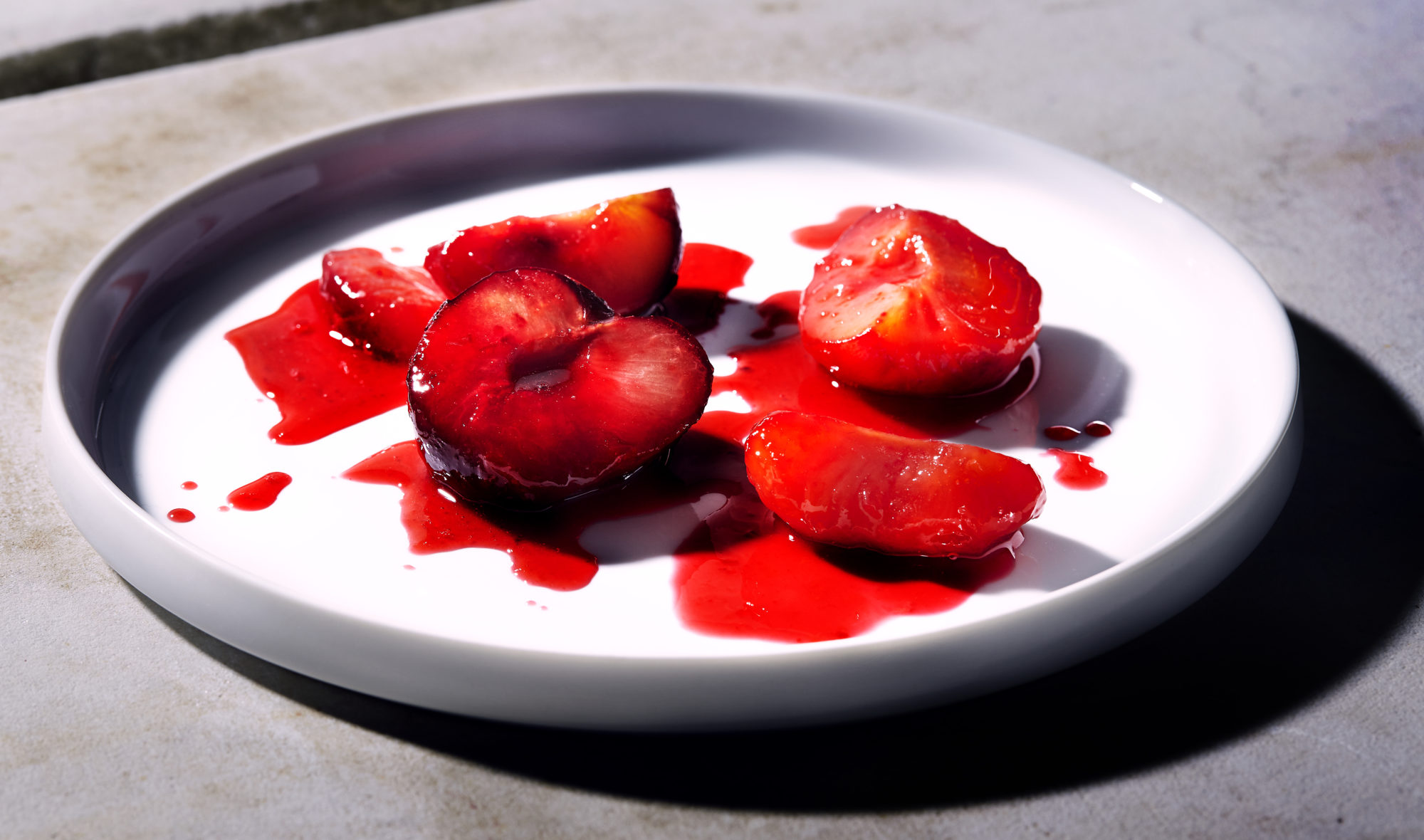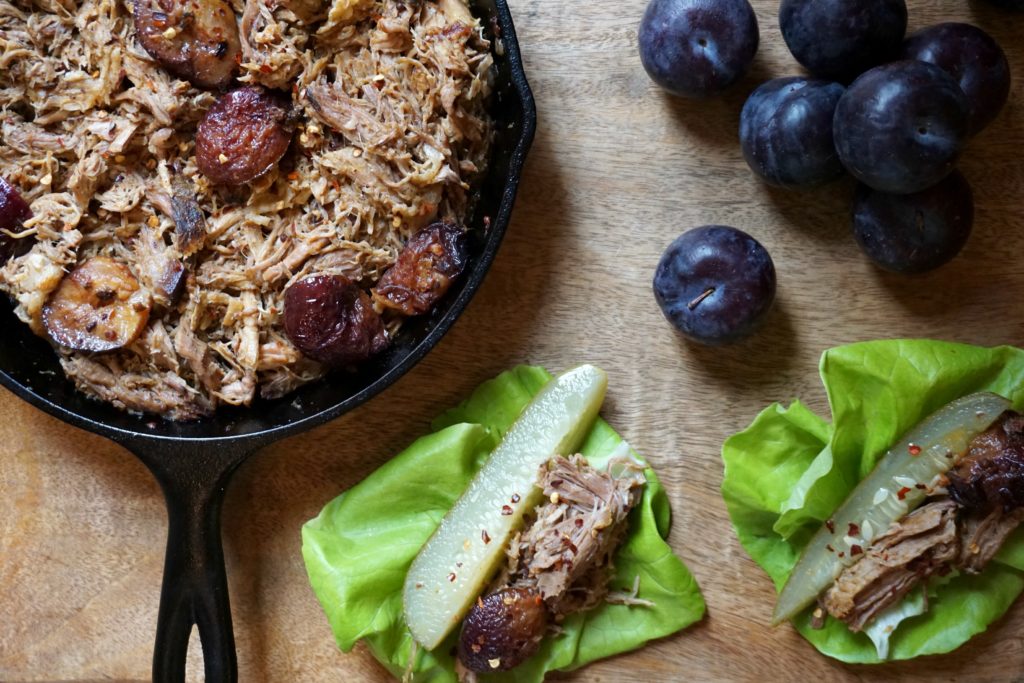Plums


Plums are a diverse species of fruit that come in a juicy panorama of colors and sizes. They can be as large as a baseball or as small as a cherry. They can be golden like the sun, green like grass, blushing like an angry cheek, or purple-black like the night sky. Plums are stone fruits, which means their seeds are encased in a hard shell or pit. Other stone fruits related to plums include peaches, apricots, cherries, and almonds. Most plums are delightfully sweet and juicy, and are also a good source of vitamin C. Also of note is the waxy, whitish coating present on many plums. This coating is called “bloom” and is a natural secretion from the fruit, which serves to protect the fruit from water damage or water loss. Bloom is harmless and edible. Although some prefer to polish it off, you can eat a plum, bloom and all.
Plums are a diverse species of fruit that come in a juicy panorama of colors and sizes. They can be as large as a baseball or as small as a cherry. They can be golden like the sun or purple-black like the night sky.
Plums are stone fruits, which means their seeds are encased in a hard shell or pit. Other stone fruits related to plums include peaches, apricots, cherries, and almonds.
Although up to 40 species of plums exist, two main subspecies dominate the commercial market: European plums and Japanese plums (also called Chinese plums). European plums vary greatly in size and color, while Japanese plums tend to be smallish, with a red-tinged yellow skin.
Plums have been cultivated for thousands of years; it is thought to be one of the first fruits domesticated by humans. Plums are grown all over the world, and are typically eaten fresh, dried (as prunes), preserved (with salt or sugar), or made into wine. Currently, China is the biggest producer of plums, followed by Romania, Serbia, and Iran.
Plums range greatly in all characteristics.
They range in color: The skin of a plum can be grass green, sunny yellow, blushing red, or midnight-black. The color can be even, ombre, or mottled. Most plums are golden on the inside, but some are red or green.
They range in size and shape: Plums can be as small as a cherry or as big as a baseball. Some are a near-perfect sphere while others are more oblong. Some have a cleft running along the length of one side, and others don’t. All will have a little dimple at the top, with or without a stem still attached.
They range in flavor: Most plums are sweet and juicy, with a tartness that tends to concentrate near the skin. However, some are cheek-puckeringly sour. These varieties are usually reserved for jam and are made palatable with the help of lots of sugar.
You may notice that many plums have a waxy, whitish coating. This coating is called “bloom” and is a natural secretion from the fruit. The bloom serves to protect the fruit from absorbing excess water as well as losing water. Usually, the presence of bloom means a plum is fresh and not overhandled. Bloom is harmless and edible. Although some prefer to polish it off, you can eat a plum, bloom and all.
One medium-sized plum (about 66g) has 30 calories, 0.5g protein, 0.2g of fat, 7.5g of carbohydrates, 0.9g fiber, and 6.6g sugar. Plums are a good source of vitamin C.
Plums are available at many larger grocery stores and fruit and vegetable markets year round.
When selecting plums, look for those with deeply-colored, unblemished skin. Give the fruit a gentle squeeze, and a sniff too – a ripe plum will feel slightly firm yet will yield to gentle pressure. It should smell sweet and fruity. Good plums will often feature a bloom – a whitish, waxy coating that occurs naturally to protect the fruit. Avoid plums that feel overly soft or those with brown spots, as they are likely past their prime.
The storage of your plums depends on how ripe they are when you bought them.
Ripe plums should either be enjoyed right away, or stored in the fridge for a few days. Plums that are not yet ripe can be left at room temperature – just check them daily to make sure they don’t get overripe.
Plums can also be frozen. Simply slice, remove the pit, and store slices in a sealed container or resealable bag in the freezer for up to six months.
Plums don’t need any preparation to eat, other than a quick wash.
Just like a juicy peach, plums can be consumed sloppily and joyfully with the help of a napkin or a damp dishcloth. (Count on dribbles! They are juicy!)

Pulled pork is a slow-cooked delight. Although it takes time, it is largely a passive process, and the results are delectable. In this particular version, plums add a subtle sweetness and soft texture. Pulled pork is delicious in tacos, sandwiches, wraps, salads, or served alongside your choice of whole grains and veggies. It goes particularly well with pickles, whose sour tang balances the pork’s rich flavor.
Prep Time: 15 minutes Cook Time: 360 minutes Yield: 8-10 servings
Preheat the oven to 350 degrees Fahrenheit, then prepare the rub: Place coriander seeds in a mortar and pestle and grind to a coarse powder. Add paprika, chile flakes, garlic, and coconut sugar, and grind some more until a thick paste is achieved.
Line a roasting pan with 4-5 sheets of overlapping foil so there’s plenty hanging out over all sides – enough to wrap loosely around the pork. Place the pork in the middle of the pan on top of the rack, and then rub the spice paste onto all sides of the pork shoulder, making sure all areas have been seasoned. Pull the tinfoil up and over the pork, bunching the edges together at the top to make a loose, sealed parcel. Pour 1 cup of boiling water into the base of the pan (not over the pork), and place in the oven.
Roast the pork for about 4.5-5 hours. Check periodically to make sure there is still water in the base of the pan. When the time is up, remove the pork from the oven.
Peel open the tinfoil (being careful of the hot steam that emerges), and arrange the plum halves along the base of the tinfoil, nestled under the pork. Raise the oven temperature to 425 degrees Fahrenheit, and place pan back in the oven for 30 minutes. After this time has elapsed, removed the pork from the oven and transfer the meat to a large, deep pan, wok, or skillet. Reserve the cooked plums and set them aside.
Using two forks, tear the pork into shreds. Remove the bone if there is one. Add the juices and fat from the base of the tinfoil, plus 1 cup of broth to the pan, and heat over medium-high, stirring frequently until most of the liquid has evaporated. Then, remove from heat, add back the reserved plums, and season with salt and pepper to taste.
Serve pulled pork on lettuce cups, topped with cooked plums, slices of pickle, and thinly sliced shallots. Enjoy!
Precision Nutrition’s Encyclopedia of Food expands every single month as we highlight new foods and showcase beautiful food photography. If you’d like to stay up to date, simply click this link. From there, we’ll send you a FREE copy of our recipe book. We’ll also let you know when new and delicious foods are added to the site.
Plums are a diverse species of fruit that come in a juicy panorama of colors and sizes. They can be as large as a baseball or as small as a cherry. They can be golden like the sun, green like grass, blushing like an angry cheek, or purple-black like the night sky. Plums are stone fruits, which means their seeds are encased in a hard shell or pit. Other stone fruits related to plums include peaches, apricots, cherries, and almonds. Most plums are delightfully sweet and juicy, and are also a good source of vitamin C. Also of note is the waxy, whitish coating present on many plums. This coating is called “bloom” and is a natural secretion from the fruit, which serves to protect the fruit from water damage or water loss. Bloom is harmless and edible. Although some prefer to polish it off, you can eat a plum, bloom and all.